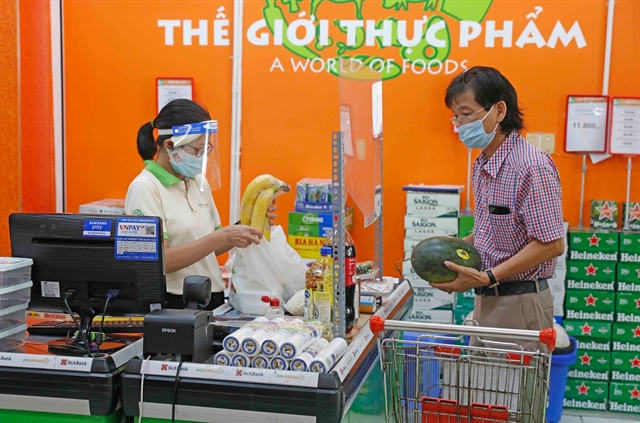 Economy
Economy

Growth will however be lower than the 8 per cent target set earlier in this year, the online newspaper Kinh tế & Đô thị reported the MoIT as saying.

|
| A man pays for his goods at a BRG Food supermarket. — VNA/VNS Photo Trần Việt |
HÀ NỘI — The retail sale of consumer goods and services is likely to increase by 3-4 per cent by the end of this year, the Ministry of Industry and Trade (MoIT) has forecast.
According to the MoIT, growth will however be lower than the 8 per cent target set earlier in this year, reported the online newspaper Kinh tế & Đô thị.
From now until the end of the year, the ministry said it would focus on removing difficulties for manufacturing enterprises, especially for larger businesses operating in industrial zones, allowing them to resume production in time for the expected increase in demand at the end of the year. It is hoped that this increase will offset the economic decline caused by months of COVID-19 restrictions.
The ministry will utilise opportunities created by free trade agreements and focus on removing obstacles to penetrate new markets. It will also closely monitor supply and demand and the prices of essential commodities to draw up regulatory measures, as well as ensuring sufficient distribution of essential goods among regions, especially in pandemic-affected areas.
Top priority will be given to bettering market inspection and supervision in the remaining months of this year, promptly detecting violations relating to speculation, smuggling, counterfeit and poor quality goods, to facilitate the presence of Vietnamese goods in the domestic market.
Importance will also be placed on the gradual reopening markets, trade centres, supermarkets and convenience stores which have ensured pandemic prevention and control measures, and implementing price-stabilisation programmes and promotional events for the upcoming Tết holiday (which falls on Feburary 1, 2022).
The ministry will also help businesses participate in online trade promotion programmes and business matching events, both at home and abroad. The utilisation of digital platforms will help increase the consumption of goods in the last months of the year, and next year as well.
According to the MoIT, total retail from consumer goods and services in September increased 65.5 per cent against August, as production, business and services resumed in some localities.
However, the country’s total retail sales and services revenue saw a year-on-year slump of 7.1 per cent to VNĐ3.336 quadrillion (US$148 billion) in the first nine months of this year, due to the COVID-19 pandemic.
Retail sales of goods in the period was estimated at over VNĐ2.77 quadrillion, accounting for 82.54 per cent of total retail sales of goods and services, and a decline of 3.38 per cent compared with last year’s figure.
Revenue from accommodation and catering services reached VNĐ279.4 trillion, down 22.14 per cent year-on-year. Revenue from tourism and other services reached VNĐ4.63 trillion and VNĐ303.97 trillion, falling 64 per cent and 19.3 per cent respectively compared with the same period last year.
Domestic trade’s proportion of the country’s GDP is expected to rise to 15 -15.5 per cent in the next 10 years, under an approved strategy for developing domestic trade between 2021 and 2030.
By 2030, domestic trade via e-commerce will likely increase by about 20-21 per cent annually to account for 10.5-11 per cent of total retail sales of goods and consumer service revenue. The percentage of small and medium-sized enterprises involved in trading activities is hoped to surpass 40-45 per cent.
The strategy looks to achieve fast and sustainable growth of domestic trade, build brands for Vietnamese goods, and protect the interests of consumers, businesses, and the national economy.
Among the main orientations to develop domestic trade, authorities are set to press on with improving the investment and business climate, form a market order adaptable to the new operating conditions, develop domestic trade stably and sustainably, keep domestic trade’s growth faster than GDP growth, and develop e-commerce into the main form of trading. — VNS